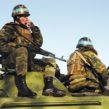
RUSSIA REINFORCES FORCES IN ABKHAZIA AS A POSSIBILITY OF ARMED CONFLICT LOOMS
Publication: Eurasia Daily Monitor Volume: 5 Issue: 84
By:

On April 29 the Russian Foreign Ministry accused Georgia of concentrating forces and weapons in the upper part of the Kodori Gorge in Abkhazia. An official foreign ministry communiqué stated, “More than 1,500 Georgian army and police personnel are already in the Kodori Gorge.” According to the foreign ministry, the Georgian troop concentrations in the Kodori Gorge “constitute a preparation of a bridgehead to begin a military operation against Abkhazia.” On the same day, the Russian Defense Ministry in a separate statement accused Georgia of concentrating troops, of moving mortars and 122mm guns into the Kodori Gorge and of threatening to use force and provocations against Russian peacekeepers. The defense ministry warned Georgia that “Any attempts to use force against Russian peacekeepers or Russian citizens on the territory of Abkhazia and South Ossetia will be met with a stringent and adequate response.” The ministry announced that it would deploy more peacekeeping troops in Georgia and establish 15 additional outposts (RIA-Novosti, April 29).
Tbilisi responded by denying that it was concentrating military forces in the Kodori Gorge or preparing to use force against Abkhazia or South Ossetia. Georgian Prime Minister Vladimir Gurgenidze objected to the Russian decision to send in additional troops and accused Russia of “potential aggression” that might further destabilize the situation. According to Gurgenidze, additional Russian troops and armor have already crossed the border into Abkhazia and are moving south to the Inguri River that separates Georgian and Abkhaz controlled territory (RIA-Novosti, April 29).
Abkhazia and South Ossetia are breakaway regions of Georgia that have been de facto independent since 1993 after bloody civil wars. In recent years up to 80 percent of the residents of Abkhazia and South Ossetia have been issued Russian passports (Interfax, April 28). The announcement by Russia that it is ready to defend Russian citizens on the territory of Abkhazia and South Ossetia “against any attempt to use force by Georgia” in effect officially makes the two breakaway regions Russian protectorates. This is a further escalation of the already tense situation between Moscow and Tbilisi. Two weeks ago Vladimir Putin issued an executive order authorizing the “improvement of relations” between Russian government agencies and the authorities in Abkhazia and South Ossetia. This was denounced in Georgia as “creeping annexation.” Last week a Russian jet fighter allegedly shot down an unarmed Georgian reconnaissance drone over the territory of Abkhazia (see EDM, April 24).
The upper Kodori Gorge was not taken over by Abkhaz forces in 1993, when they defeated and expelled the Georgian forces and population. A local militia controlled the upper Kodori until 2006, when Georgian regular forces moved in and the pro-Georgian government of Abkhazia in exile was moved from Tbilisi to the Kodori Gorge. After that the upper Kodori was officially renamed Upper Abkhazia. The government in exile represents the estimated 200,000 to 400,000 Georgian exiles that were evicted in an orgy of mass rape, looting and killings by the victorious Abkhaz in 1993 (Los Angeles Times, April 17).
The upper Kodori is a valley, surrounded by high mountain ridges: The Main Caucasian Ridge to the north, the Kodori and Abkhaz ridges to the south and west. Last year the Georgians built a road over a mountain plateau to the east, connecting the upper Kodori to Georgia proper. Before that, upper Kodori was isolated for most of the year.
An old Soviet-built road connects the upper Kodori with the lower Kodori Gorge and the coastal plane near the Abkhaz capital of Sukhumi. The Kodori River cuts a steep gorge between the Kodori and Abkhaz mountain ridges. This middle part of the Kodori Gorge is an uninhabited wilderness, virtually impassable by heavy military equipment, since the Soviet-built road has become totally derelict since 1991 and there are two Russian military outposts on the way.
If indeed the Georgians have massed 1500 troops with some guns in the upper Kodori, they cannot possibly be used as “a bridgehead” to begin an attack on Abkhazia. The upper Kodori is a geographically bottled up place: Several hundred Georgian solders could possibly infiltrate down through mountain trails without heavy weapons, but on the coastal plane they would surely be outnumbered, outgunned and wiped out by Russian and Abkhaz armor.
Last October at a press conference in Moscow the Abkhaz leader Sergei Bagapsh told journalists that his government was seriously considering an operation to oust Georgian forces and the pro-Georgian Abkhaz government out of the upper Kodori, stating that full control of all of Abkhaz territory might facilitate recognition of the separatist regime. Such an operation by Abkhaz forces with Russian support may now be in the offing. While there is fighting in the Kodori, the reinforcement of Russian peacekeepers on the Inguri separation line makes sense to keep the Georgians at bay. Russian threats maybe intended as a warning to prevent a Georgian overreaction that could transform a relatively limited Kodori operation into all-out war. Such a scenario seems more plausible than Russia’s latest improbable statements about Georgian aggression from a “Kodori bridgehead.”




